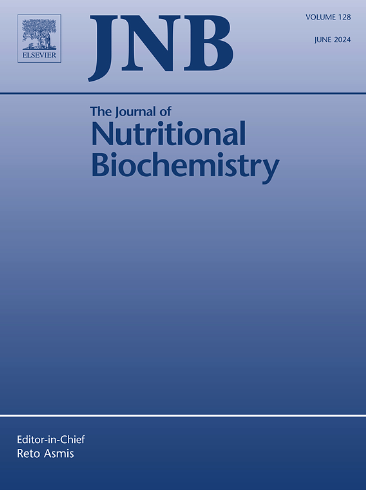Linoleic acid modulates vascular reactivity, alters cyclooxygenase-2-derived products, and promotes eutrophic remodeling in small mesenteric arteries of normotensive rats
IF 4.8
2区 医学
Q1 BIOCHEMISTRY & MOLECULAR BIOLOGY
引用次数: 0
Abstract
Linoleic acid (LA) is a polyunsaturated fatty acid with essential roles in cardiovascular regulation. Despite its known vascular effects, its impact on mesenteric resistance arteries (MRA) in normotensive models remains unclear. This study aimed to determine whether LA induces functional and structural changes in MRA of normotensive rats by modulating endothelial mechanisms. We hypothesized that LA treatment reduces vasoconstrictor reactivity and promotes vascular remodeling via enhanced nitric oxide (NO) bioavailability. Male Wistar rats were treated with LA (15 mg/kg) or vehicle for 15 days. LA did not alter blood pressure, mechanical parameters, or collagen and elastin levels in the MRA, but it increased both external and internal diameters of the vessels, reducing the wall-to-lumen ratio. LA decreased the contractile response to phenylephrine, without affecting responses to acetylcholine or sodium nitroprusside. l-NAME (100 µM) enhanced vasoconstriction to a greater extent in the LA-treated group, associated with increased nitric oxide (NO) bioavailability, independent of inducible NO synthase (iNOS) and phosphatidylinositol 3- kinase (PI3K). The NADPH oxidase pathway had a lesser impact on vasoconstriction in the LA group, although the superoxide anion scavenger tiron (1 mM) and the production of reactive oxygen species showed similar results. Inhibition of ciclooxigenase (COX) and cytochrome-P450 (CYP450) attenuated vascular reactivity in the LA group, with greater involvement of COX-2-derived products. While SC 19220 (EP1 receptor antagonist, 10 µM) reduced vasoconstrictor responses to phenylephrine only in MRA from the LA-treated group, SQ 29.548 (TP receptor antagonist, 1 µM) reduced responses only in controls. In conclusion, LA reduces vasoconstriction, increases NO bioavailability and decreases NADPH oxidase participation associated with alterations in CYP450 and COX-2-derived products.
亚油酸调节血管反应性,改变环氧合酶-2衍生产物,促进正常血压大鼠肠系膜小动脉富营养化重塑:亚油酸诱导的血管调节和重塑
亚油酸(LA)是一种多不饱和脂肪酸,在心血管调节中起着重要作用。尽管已知其血管作用,但在正常血压模型中其对肠系膜抵抗动脉(MRA)的影响尚不清楚。本研究旨在确定LA是否通过调节内皮机制诱导正常血压大鼠MRA的功能和结构变化。我们假设LA治疗通过提高一氧化氮(NO)的生物利用度来降低血管收缩剂的反应性并促进血管重塑。雄性Wistar大鼠分别给予LA (15 mg/kg)或对照剂治疗15 d。LA没有改变血压、机械参数或MRA中的胶原蛋白和弹性蛋白水平,但它增加了血管的内径和外径,降低了壁腔比。LA降低了对苯肾上腺素的收缩反应,而不影响对乙酰胆碱或硝普钠的反应。L-NAME(100µM)在la处理组中更大程度地增强血管收缩,与一氧化氮(NO)的生物利用度增加相关,不依赖于诱导型NO合成酶(iNOS)和磷脂酰肌醇3-激酶(PI3K)。在LA组,NADPH氧化酶途径对血管收缩的影响较小,尽管超氧阴离子清除剂铁(1 mM)和活性氧的产生显示出相似的结果。环氧化酶(COX)和细胞色素p450 (CYP450)的抑制降低了LA组的血管反应性,COX-2衍生产物的参与程度更高。SC 19220 (EP1受体拮抗剂,10µM)仅在la处理组的MRA中降低血管收缩剂对苯肾上腺素的反应,SQ 29.548 (TP受体拮抗剂,1µM)仅在对照组中降低反应。总之,LA减少血管收缩,增加NO的生物利用度,减少NADPH氧化酶参与,这与CYP450和cox -2衍生产物的改变有关。
本文章由计算机程序翻译,如有差异,请以英文原文为准。
求助全文
约1分钟内获得全文
求助全文
来源期刊

Journal of Nutritional Biochemistry
医学-生化与分子生物学
CiteScore
9.50
自引率
3.60%
发文量
237
审稿时长
68 days
期刊介绍:
Devoted to advancements in nutritional sciences, The Journal of Nutritional Biochemistry presents experimental nutrition research as it relates to: biochemistry, molecular biology, toxicology, or physiology.
Rigorous reviews by an international editorial board of distinguished scientists ensure publication of the most current and key research being conducted in nutrition at the cellular, animal and human level. In addition to its monthly features of critical reviews and research articles, The Journal of Nutritional Biochemistry also periodically publishes emerging issues, experimental methods, and other types of articles.
 求助内容:
求助内容: 应助结果提醒方式:
应助结果提醒方式:


